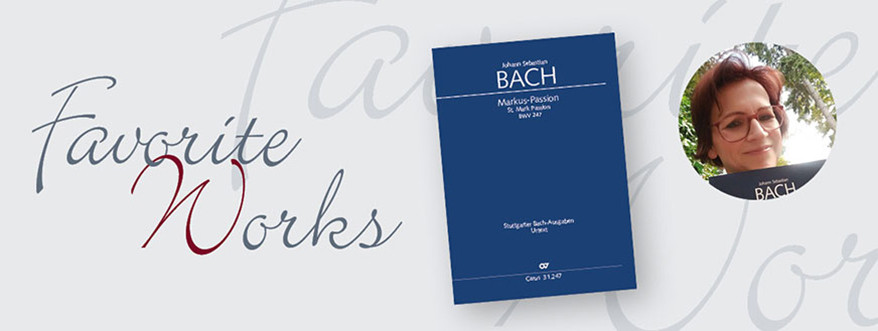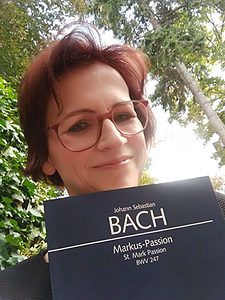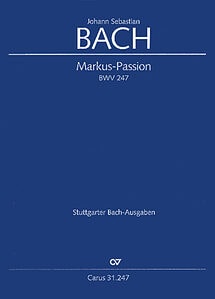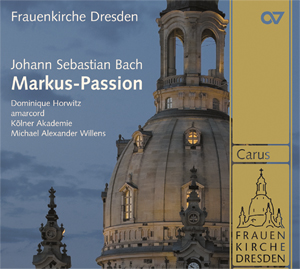Like a detective novel
A work where not a single note of it survives
When asked about her favorite composers or indeed a favorite piece, Ute Kelemen could give a whole range of different answers. But if she really wanted one composer for her spell on that desert island, then it would be Bach. A single chorale by him holds so much comfort and hope that she would be able to survive for a while.
The discovery of the year for me was Bach’s St Mark Passion. This was for the most unattractive of reasons – Corona. We members of the Dresden Philharmonic dutifully stayed at home from the 13th March – all our concerts were cancelled. In Holy Week it became particularly clear to me that without music, without a Passion performance, this time was just not the same. Ever since I experienced my first St John Passion singing as a 10-year-old in my father’s choir, there has hardly been a year when I haven’t sung, played in, or at least heard either the St Matthew or the St John Passion.
So I began to search for something to fill the gap. I wanted to find something new, and to my surprise, I had to admit that I had never come across the St Mark Passion. My researches into this soon became quite exciting: first performance in 1731 in Leipzig, just a few years after the St Matthew Passion, Picander’s libretto survives complete, the autograph score lost. A copy made by the Bach collector Franz Hauser (1794–1870) may have contained parts of the St Mark Passion, but was destroyed in 1945 at the end of the war, without ever having been properly evaluated.
The story of the St Mark Passion reads like a detective novel. How do you reconstruct a work when not a single note of it survives? Wilhelm Rust (1822–1892, editor of the old Bach Complete Edition) recognized in 1873 that five movements of the St Mark Passion were probably borrowed from Bach’s Trauerode. Later on, in the 1940s Friedrich Smend (1893–1980) was able to locate the parody model for a further aria and some of the chorales. On the basis of this material Diethard Hellmann (1928–1999) published an edition in 1964 and suggested two performance options: either you reduce everything to a two-part Passion cantata and only perform what can be derived from it (that means the surviving text would be reduced to about a quarter), or you follow the Picander text, perform what can be reconstructed, and the rest (all the recitatives, plus the Turba choruses and an aria) is spoken. Spoken? Maybe I had the prospect of an exciting evening at the theater with music?
But that was not yet the end of the story. A chorale collection by the Bach pupil Ludwig Dietel (1713–1773), written around 1735 and its significance long underestimated, contains not only the missing chorale movements from the St Mark Passion, but in this source they are even in exactly the same order as in Picander’s libretto. It is therefore not too far-fetched to imagine that Dietel might have been able to copy this directly from the autograph score of the St Mark Passion, which was then still to hand. Dietel’s copies are essentially the only truly reliable source for the St Mark Passion – at least as things stand. But who knows whether another manuscript might not emerge at some point? In 2000, Andreas Glöckner newly edited Hellmann’s reconstruction for Carus, now with all the chorales.
So much about the history of the Passion setting. The theater evening lived up to its promises (CD with amarcord from the Frauenkirche Dresden – Carus 83.244). I held my breath when I heard the first recitatives and choruses spoken. What a difference! You suddenly pay much more attention to the story. St Mark’s Gospel is very similar to St Matthew’s, but every now and then, when you feel as if you are on familiar territory, it takes a different turn. And when the next chorale is sung, then it is as if you had never heard music before. So pure and innocent. Like eating again for the first time after fasting for a week.
Of course I couldn’t help but hear the music of the St Matthew Passion in almost every recitative and chorus. Others will feel exactly the same. Despite many parallels, St Mark’s Gospel places the human side of Jesus more strongly to the fore. Jesus has feelings, is angry and sad, he is hungry, tired, embraces children, and shakes with the fear of death. My personal highlight was the soprano-violin aria “Welt und Himmel, nehmt zu Ohren, Jesus schreiet überlaut”. It follows the recitative in which Jesus dies. I began to practise this, and performed it at some of our first small 1:1 concerts after lockdown. The aria in G major in 6/8 time is cheerful, optimistic, as if nothing had happened.
Another interesting detail occurred to me. In the St Matthew Passion there is just one place where the choir sings in unison “Ich bin Gottes Sohn”. In the St Mark Passion this happens in the final chorus: “Mein Leben kömmt aus deinem Tod, hier hab ich meine Sünden not”. This “epitaph” is heard four times in total, and has the effect almost of a mantra. As earlier in the Trauerode, something quintessential, something which endures is pointedly placed under the spotlight through the use of unison.
After Hellmann’s edition, soon there were the first attempts at a completion with new compositions for the recitatives and turba choruses. But they all have one thing in common – they don’t really sound like Bach. I can understand that there is a desire to create a performable complete work, and that the “right” St Mark Passion remains a utopian dream, but I would not want to forego the magic of Andreas Glöckner’s solution, although I accept its limits. Peter Uehling, a church musician in Berlin has recently published an interesting approach to the work with Carus: for the spoken Gospel story, he has written a discreet accompaniment for gamba and cello, supporting the content of the text. The musical flow is maintained, without it sounding like the “wrong” Bach. And a positive side effect is that the choir can find its next notes.
And finally, a thought about performance options. In these times it is not at all certain whether normal concert life will have resumed by Easter 2021. With a duration of 75 minutes, the St Mark Passion is not only much shorter than the Matthew or John Passions, it also only requires three soloists and a much smaller orchestra than the two major Passion settings by Bach. It is therefore easier to perform under current conditions. I might perhaps engage a speaker or actor for the spoken part. The narrator is the central figure and the story therefore stands or falls depending on his or her performance.
I wish you much enjoyment with the St Mark Passion.
Ute Kemelen (née Graulich) studied violin with Thomas Brandis in Berlin and Eszter Perényi in Budapest. She has been a violinist in the Dresden Philharmonic since 1993.







Leave a Reply
Want to join the discussion?Feel free to contribute!